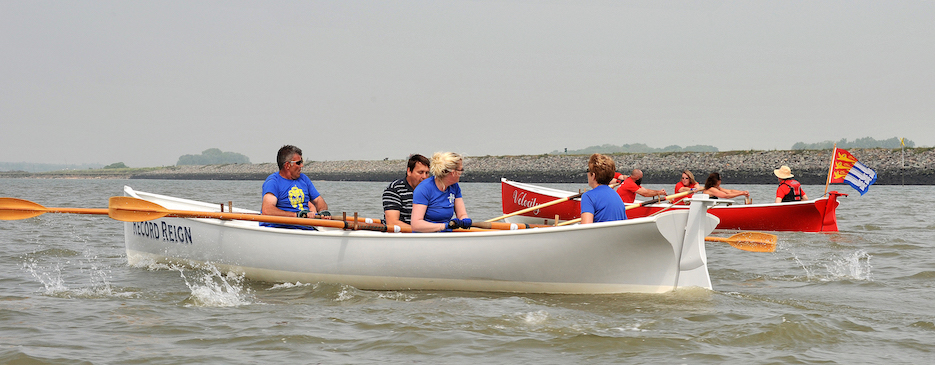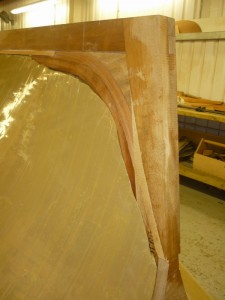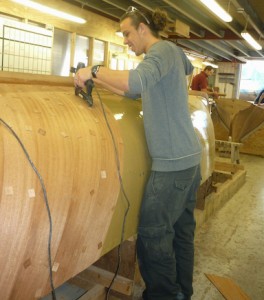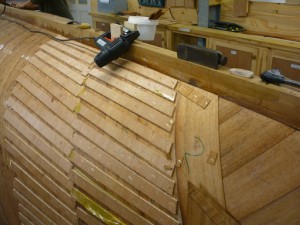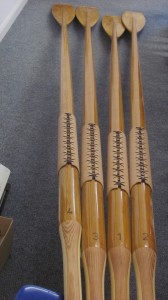Racing to keep up with demand – by Julia Jones
How the restoration of Pioneer produced a training scheme for apprentices which has led to a whole new interest in competitive rowing.
Sandwiched between two examples of traditional boatbuilding craft at 2015’s Woodbridge Maritime Festival – a replica of the Sutton Hoo Viking burial ship and a Celtic curragh – was, in this context, a startlingly-modern rowing gig: Matchless, gig No 4 from Harker’s Yard, Brightlingsea.
Matchless and her many fellow gigs are the product of a training scheme set up in the wake of the rescue and rebuild the 1864 first class smack Pioneer, ‘Last of the Skillingers’, now relaunched as a sail training ship. The shipwrighting skills involved were considerable and other restoration projects naturally followed. Harker’s Yard was set up by the Pioneer Sailing Trust, primed with money from the EU Transcoast Project which aimed to regenerate port areas and help them reintegrate with their local communities.
Soon, the emphasis within the trust shifted slightly away from the material heritage towards embedding skills for the future. Specifically they wanted to focus on training apprentices as the craftsmen of the 21st century and they wanted them to learn through involvement with real build projects. Restoration work might not offer the orderly progression or range of skills to educate youngsters who might have no previous wood working experience at all.
Shaun White, one of the two master shipwrights who had worked on the Pioneer, therefore spent a year developing and building the first of the Harker’s Yard gigs. The idea came from the success of the Cornish pilot gigs but the Harker’s Yard design was adapted from a traditional East Coast model. At 24ft (7.3m) the Harker’s Yard gigs are shorter than the west country types and are rowed by a crew of four (plus a cox) rather than six.
White’s crucial innovation, however, was to move away from clinker to cold-moulded construction. Transcoast and other development money helped to provide the facilities and the time he needed to build the ‘plug’ – the mould that is used to shape the hulls of all the Harker’s Yard gigs (and also the purpose-built trailers in which they are transported). He and the then apprentices produced gig No 1, Velocity, which was launched in 2012, only the second newly-built craft to have been publicly launched in Brightlingsea for ten years.
Since then the project has gone from strength to strength. “Every time we deliver one,” says Fred Dorrington of the Pioneer Sailing Trust.“We get orders for two or three more.”
The primary importance of the cold-moulded process is the range of skills that the apprentices must learn. These begin with ‘skinning-up’ where the three thin layers of mahogany are laid diagonally onto the mould once the backbone of the gig is in position. The first layer is stapled; the rest are glued. The technique is very simple: what is required from the apprentices is to position each strip with the utmost care and precision. Tyler, an apprentice in only his fourth week at the yard explained how much he enjoyed having to concentrate on “doing it right”.
The apprentices must then remove the core from the mould and place it in the cradle where they learn the processes of fitting out. They fix thwarts, knees, floors and gunwales and practice all the ancillary techniques such as sanding and planing. Some will become adept at sourcing timber, others will develop their expertise in using the patterns originally developed by Shaun White to cut out the component parts. Then the gig is moved into a separate container where it is painted first with epoxy paint and finally with a top coat and her name.
Most of the Harker’s Yard gigs bear the names of long-dead smacks. Gig No 2, Vanduara, for instance perpetuates the memory of another of the ‘skillingers’ – those big 19th-century Brightlingsea smacks which crossed the North Sea to dredge for oysters off Terschelling. The remains of Vanduara lie on Peewit Island in the Pyefleet and it’s satisfying to think that members of the Brightlingsea Coastal Rowing Club, who own both Vanduara and Velocity, might sometimes spare her a thought as they pass by.
Each of the gigs takes about 2,000 man hours or a year’s work for one person. Currently the apprentices, under the supervision of their tutor, John Lane and the gig manager, Dunstan Pugh, are producing three or four gigs a year. They are also learning to make oars for the gigs – flat-bladed oars that are slightly more robust and only a little less powerful than the spoon-face oars supplied by Suttons, the specialist makers in Windsor. Each set of oars can count as another piece of course-work for the apprentice as he or she works towards their City and Guilds qualification.
Clubs can now buy a total package, everyday-quality oars, specially designed trailer and fitted covers as well as the gig itself. The gigs cost £12,000 each, the extras £3,000. Dunstan Pugh admits that there is sometimes a moment of sadness experienced by the teams as their most recent offspring leaves the yard.
The Harker’s Yard babies set off to lead robust and busy lives. Gig racing and coastal rowing is a fast-growing sport. Local clubs have been established at Wivenhoe, Rowhedge, East and West Mersea, Maldon, Bradwell and Burnham. (As of July 2019 a total of 13 clubs are racing the 20 wooden gigs built so far.) There’s an attractive ‘have-a-go’ community aspect to this type of rowing and all the clubs run regular free taster sessions. It appeals to people with a reasonably wide range of age and fitness levels, who enjoy the social and recreational aspects as well as the links to the past.
Nevertheless there’s always the potential for fierce competition. “We don’t hold back in races,” said Fred Dorrington and I was amused to read a more colloquial social media comment from a local club member who described him or herself as “buzzin’ for some kick-ass racin’”. Locally there’s both a summer and a winter series featuring mixed as well as men’s and ladies’ teams with particular emphasis, in the winter months, placed on the importance of bacon sandwiches. There are collisions and gigs have to return to be repainted. I was rather struck by Dorrington’s explanation of the two thole pins in each rowing position: the aft pin is hard wood but the forward pin is soft wood, deliberately designed to break easily if an oar goes too deep or feathers accidentally. In general, however, the cold-moulded construction has proved exceptionally durable and maintenance-light.
Matchless is Harker’s Yard’s own gig. As well as strutting her stuff at exhibitions and festivals she is there to be rowed by the builders themselves. Though her name is not as often on the leader boards as her community-owned sisters, she is an ever-present inspiration. I overheard an apprentice and a work-experience student talking about her as we motored back from a trip to visit Pioneer. “I wonder if we could make her sail,” said one to the other. That’s presumably what the Vikings thought.


